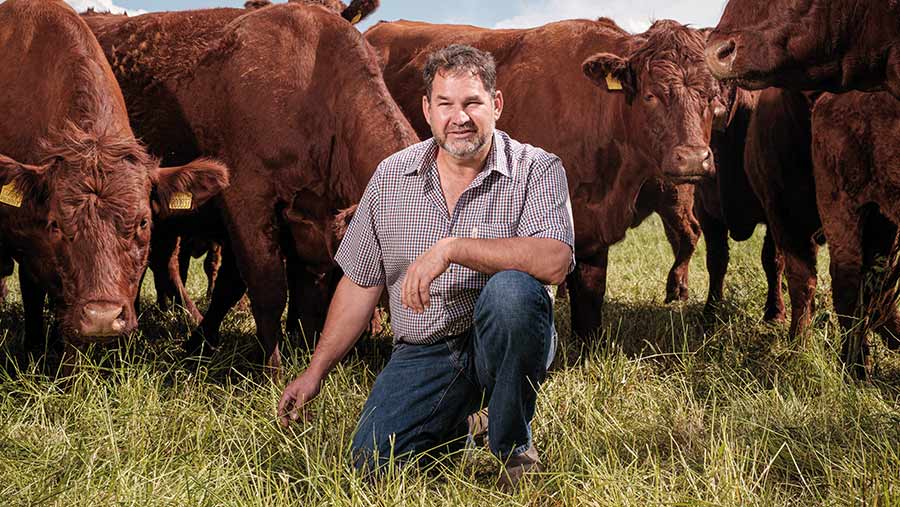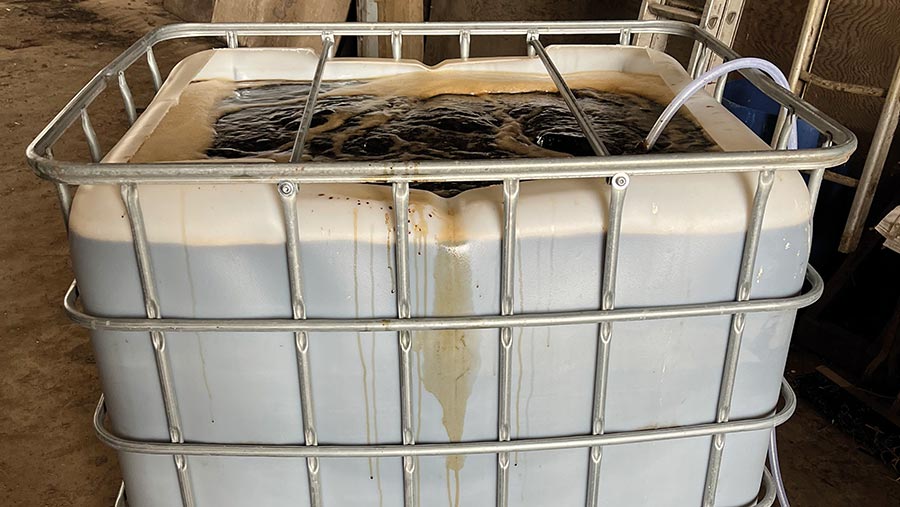Biological brews help grower keep crop disease at bay
 Angus Gowthorpe © Jim Varney
Angus Gowthorpe © Jim Varney A focus on biological brews is successfully controlling disease for Yorkshire farmer Angus Gowthorpe, as wet spring weather has brought an influx of disease pressure to many crops across the UK.
Last season, the home-brewed microbe and fungal mix completely eliminated artificial fungicide use, saving more than £90/ha on a typical winter wheat field, while yields were maintained.
See also: Farmer grazes 2,500 sheep on cereal crops for disease control
Together with careful selection of an eight-way wheat blend, the use of silicon sprays and regular sap testing, Angus is fuelling both soil and crop health.
That’s why he is confident crops at Approach Farm will withstand this season’s high disease pressure.
Farm facts
- 160ha mixed arable and beef farm in North Yorkshire with 40 pedigree Saler suckler cows
- Biological brew mixes used as the farm’s main disease control
- Eliminated use of fungicides, plant growth regulators, insecticides and purchased phosphorus and potassium
- Foliar amide nitrogen offers five times greater efficiency than granular N
- Operates a contract direct-drilling business alongside the farm
Starting the no-fungicide transition
Eight years ago, Mr Gowthorpe decided to farm with as few artificial inputs as possible and instead shifted his attention to natural alternatives. It began with the reduction of nitrogen fertiliser.
Nitrogen rates were cut from 200kg/ha to 180kg/ha, then to 150kg/ha and finally to 130kg/ha over a four-year period.
He then began using a foliar nitrogen feed, which offers five times more efficiency than granular N.
The drop in nitrogen fertiliser reduced the rapid development of a lush, green canopy that would otherwise increase susceptibility to disease breakdown and risk lodging due to weak plant structure.
This prompted the next step of cutting back fungicides and seeking a natural alternative.
While speaking with other regenerative farmers, he came across the concept of home-made biological brews, which he decided to try.
Wheat blends
Growing an eight-way blend of different wheat varieties, each with different parentage, is helping Angus Gowthorpe keep his crops healthy and free from disease.
He says the blend, consisting of Graham, Gleam, Lantern, Detroit, Extase, Costello, Cranium and Parkin, increases the genetic diversity of crops to ensure as many beneficial crop traits are exploited as possible.
Two years ago, when growing the variety Shabras in a four-way blend, it became susceptible to a late influx of yellow rust, which resulted in a synthetic fungicide spray being applied.
Since dropping Shabras from the blend and avoiding varieties with its parentage, yellow rust has not been an issue.
Angus worked closely with the AHDB to develop a wheat variety blend calculator using the variety parentage of each cultivar.
This enables growers to design their own blend while accounting for parentage as well as other factors when deciding which varieties to grow.
When growing winter barley, Angus opts for a four-way blend of Tardis, Hawking, Valerie and Mountain.
Creating the brew
Angus now successfully brews a number of biological mixes as and when required.
All arable cropping receives a seed drench at drilling and foliar sprays throughout the growing season.
Typically, two foliar applications are made, with the first at flag-leaf emergence and the second as an ear wash spray.
Small tweaks are made depending on the season and crop.
The microbe mix is brewed in an IBC containing 2 litres of bacteria concentrate alongside 1,000 litres of water for 24 hours at a temperature of 18-20C.
As Angus is connected to a mains water supply, he aerates the water for an hour before adding any micro-organisms to avoid contamination with chlorine, which could otherwise harm the biology.

IBC brew © Angus Gowthorpe
The mix contains a range of bacillus bacteria that provide both protective and curative disease-control properties.
These include Bacillus licheniformis, Bacillus megaterium, Bacillus pumilus, Bacillus amyloliquefaciens, Bacillus subtilis and Paenibacillus polymyxa, which he purchases from a company called Aiva Fertilisers. A feed source of molasses is also added.
When the brew is destined for use as a seed drench, Mr Gowthorpe uses a slightly different biological concentrate, which includes trichoderma fungi to aid establishment and boost root health.
“I apply the seed drench down the spout at drilling using the drill’s liquid fertiliser system, which squirts the drench next to the seed in the soil.
“Trichoderma is a fungus that will essentially eat any potential disease on the seed itself. As we don’t use seed dressings, this helps clean and protect the seed, while also releasing phosphorus and nitrogen from organic matter, and targets the immediate rooting zone,” he explains.
Nutrition and crop health
Crop health and nutrition play a key role in crop production at Approach Farm, which is why Angus takes two to three crop sap samples to monitor performance throughout the growing season.
He then tops up plants with the relevant micronutrient foliar feeds to further boost performance.
“Analysing plant sap allows you to accurately assess the nutrients that are actively flowing through the plant, rather than tissue tests, which show us what has taken place two to three weeks before.
“This gives us a more accurate representation of what nutrients are available or lacking in the crop and how we can optimise this,” he says.
Alongside the foliar feeds, potassium di-silicate and salicylic acid are applied to improve crop health and robustness.
“This thickens and coats the cell wall to make it physically stronger. This makes it harder for fungal spores to penetrate and replaces the need for plant growth regulators,” he adds.
When it comes to fertiliser, just 40kg/ha of granular fertiliser is applied in the spring to get crops off to a good start.
Once the crop has established and the ground is covered with leaves, the liquid amide foliar spray which offers a more readily available N source is applied.
“This is a much more efficient use of N – about 7kg/ha of the foliar feed is the equivalent to 40kg/ha of the standard granular form,” he says.
Rotation diversity
With a no-till system put in place in 2014, Angus Gowthorpe operates a diverse eight-year rotation, growing wheat, barley, beans, oilseed rape, linseed and oats.
Thanks to his suckler herd, muck is applied across the whole rotation to improve organic matter, eliminating the need for purchased phosphorus and potassium.
He also incorporates catch and cover crops, and grassland for grazing and silage to improve soil health.
Angus was also involved in setting up the Green Farm Collective – a collaboration of six farmers who plan to add value to farm businesses that are following regenerative agricultural methods.
Farmers Weekly Awards 2023 Environmental Champion of the Year sponsor
The Farmers Weekly 2023 Environmental Champion of the Year is sponsored by the Woodland Trust.
Find more information about the Awards.


